Research Point
History of Still Life
Still Life is a painting or drawing of a group of objects either man made, natural objects or mixed together. Objects from the very beginning of Still Life were things like flowers, fruit, other foods and dead animals. Now in Still Life Art we use any objects we can get our hands on from cups,candles ornaments to mobile phones. All new technology that was created in 19th and 20th centuries till present and also new nature objects that were discovered over the years inc wild flowers.
I am now going to go through the centuries to see how it began and how it has evolved over the years.
1600 - 1700 Golden Dutch Age -Baroqu and 1800
Serious still life began in the 1500 use for bible illustrations purposes, Such as the painting below :
Christ at Emmaaus by Caravaggio (1601)
http://www.nationalgallery.org.uk/cgi-bin/WebObjects.dll/CollectionPublisher.woa/wa/work?workNumber=NG172

I noticed the still life arrangement on the table. There's bread,wine and cooked fowl. I think this is a good painting especially the people. but I think the natural objects look a bit dull, but then again back then it was only candle light they used not electricity.
During this time, Artists painted in a very realistic style (photograph like). In 1700 Still Life became a proper form of art, especially in the Netherlands.Still Life paintings were not religious or important, but the were very popular.
Pieter Claesz, Still Life with Ham (between 1625-30)
http://www.kunstkopie.de/a/claesz-pieter.html&sfl=1&INCLUDE=LIST

I really love this piece of art work, Claesz has done a grand job here , I like the way he has painted to goblets. They look real and the draped material works well. the whole painting compliments its self and the colours are very complimentary towards each other. You can tell he has put a lot of effort in to this. I do however feel that the meat (I think its meat) could of been improved as I don't think it looks as good as the rest of the painting.
Jan de Heem, Festoon of Fruit and Flowers (between 1635 and 1684)
http://www.essentialvermeer.com/dutch-painters/heem.html#.VEf_MSLF_bQ
This painting is very vibrant, which I guess he was trying to show richness in this piece of art. I can see a hook and all the produce, flowers and food are being hanged from it, I like the little added touch of the butterflies, I am guessing they was not actually there at the time but a nice way to finish the painting off. The colours work well with each other, red, oranges and yellows, I can see some blue material being used also. it all works very well on a dark background enticing you to look at the hanging object's closely.
Also around this era Vanitas Paintings came in to the art world, Vanitas, is a name that refers to a passage of the bible in Revelations, which says 'Vanity of all vanities - all is vanity' - means that every person had pleasures in there life which they loved and made them feel wealthy and important, but really it mean't nothing because eventually you die. Its quite depressing but I guess its true and means really that we should not get so attached to our favorite things. Vanitas Paintings always had expensive and fancy objects such as goblets, musical instruments and Jewellery. Also in these painting you would find skulls and candles which were reminders of this era.
Harmen Steenwijck, Still Life: An Allegory of the Vanities of Human Life (1640)
http://www.artyfactory.com/art_appreciation/still_life/harmen_steenwyck.htm
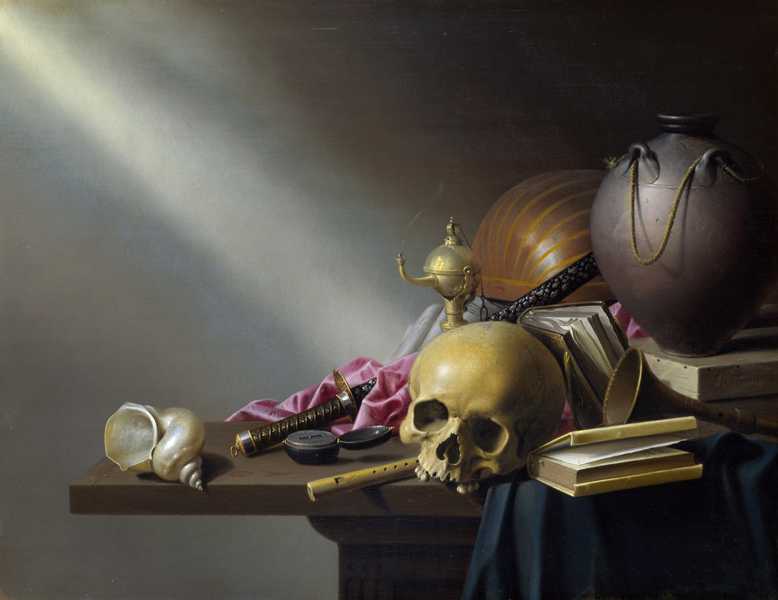 Skulls seemed to appear quite a lot in these paintings, which I consider to be a communication to the viewer of death. As though maybe this person had died and these were all there favorite belongings. I read on the link for this painting that the shell is classed to show a wealthy person as back then not many people would of had one. Back then it would of been like a collectors piece. The Silk purple cloth - This represents silk as the finest quality material and the colour purple was the most expensive dye. So in these Vanitas Paintings, I can see that each Item was put there on purpose to show wealth and the type of person they were eg books- a person who had great knowledge.
Skulls seemed to appear quite a lot in these paintings, which I consider to be a communication to the viewer of death. As though maybe this person had died and these were all there favorite belongings. I read on the link for this painting that the shell is classed to show a wealthy person as back then not many people would of had one. Back then it would of been like a collectors piece. The Silk purple cloth - This represents silk as the finest quality material and the colour purple was the most expensive dye. So in these Vanitas Paintings, I can see that each Item was put there on purpose to show wealth and the type of person they were eg books- a person who had great knowledge.
Adriaen van Utrecht, Vanitas Still Life with a Bouquet and a Skull (1643)
http://www.ft.com/cms/s/2/4f2df0e8-3248-11e2-916a-00144feabdc0.html#axzz3Gu49vl34

I like this painting you can defiantly feel the riches in this piece of work. I think it looks better then the painting above, the flowers seem to compliment the rest of the object on the table. I read on the link for the painting, that the flowers symbolize triumph in death. So this person may of be in a war, or died being a hero. I get the sense of a more elegant person in this work also, as though there more rich then the persons belongings in Utrechts painting.
1700-1800
Many painters were still continuing to paint still lifes in the 18th century. Two in particular were french artists called : Jean Siméon Chardin and Jean-Baptiste Oudry. They both enjoyed drawing dead animals for there still life work. Oudry was reowned for being an amazing animal painter of the 18th century. She was really good at hunting scenes and using dead game in her still life. Chardin introduced chiaroscuro, light and dark and reflections into his work.
Wild Duck With A Seville Oraange
Hound with Gun and Dead Game 1740
Jean-Baptiste Oudry
http://www.artsunlight.com/artist-NO/N-O0001-Jean-Baptiste-Oudry/N-O0001-0001-hound-with-gun-and-dead-game.html
I think both of these paintings are great, maybe I am a bit biased, as I love animals, though not dead ones. I do however, like how they have interpreted the animals on canvas using paint. they look really life like. I can see why Oudry was classed as a great animal painter. The work in the painting above is just amazing. The detail is so real and I just want to stroke the dog. Comparing this to the 1700, I guess in a way does still show the riches of the person/painter as they could to afford to go and hunt which was a pleasure back then and a hobby for the rich.
1800-1900
Artists in the 19th century carried on painting still lifes, yet it all started to change. Impressionists and post impressionists art forms were introduced. Artist were now not concerned about making photo realistic paintings or Painting still lifes, to show value and possessions. They were more interested in experimenting with colour and how they applied there paint to canvases to create colourful artwork.
An important master Paul Cézanne, was from this era. Some say He single-handedly raised still life to a respected art form in his time.
Cézanne
Paul Cézanne painted a large number of still lifes. Looking at his work I can see he was amazing with experimenting with colours. He used warm colours such as reds and oranges against cool colours like greens and blues to make the objects stand out at you. I can see that he just didn't just paint objects one colour, he used a mixture such as the table and back grounds to make the paintings more alive.
Cézanne, Pot of Flowers and Fruit (1888-1890)
http://www.johnlewis.com/the-courtauld-gallery-paul-cezanne-pot-of-primroses-and-fruit-1888-1890-print/p588007
|
Note the different colours in the table top and the wall behind.
Cézanne, Paul: Still Life with Ginger Jar, Sugar Bowl, and Oranges
http://www.moma.org/collection/object.php?object_id=78469
|
|
|
The colours of the blanket really work well in this painting and compliments the oranges, the warm colours in this painting. Again O ranges and greens work well in his work.
Van Gogh
Sunflowers
http://www.dailymail.co.uk/news/article-2413253/Van-Goghs-sunflowers-He-painted-seven-versions-glorious-masterpiece.html
This is another artist of this time the famous Van Gogh, He did this still life below of the sunflowers. This was quite a hot topic with van Gogh, he painted quite a few sunflower stil lifes. In 1987 one of his sunflower paintings sold for almost 40 million dollars. The use of colours are bright and such a happy feeling when looking at this painting. You can now see a difference from previous centuries -The brushstrokes, you can see then where as before applying paint was supposed to be invisible. Now the painting its self was the main focus. Artist now could paint any way they wanted, what worked for them as lond as the final result worked.
|
|
1900 - 2000
The Cubists
Georges Braque and Pablo Picasso were the ones that claimed Cezanne was the 'Father of them all' These two invented a style of painting called 'Cubism'. The idea behind it was that they took Cezannes idea of not painting things in perspective and decided to show several points of view in one peice of work. This helped to create art which was more original and effective. Although as you can see with the examples below, it is some times difficult to see what the objects were in there paintings. over the centuries now you can see we are near to abstract painting. The artist is not painting anything real at all, but just creating imaginative images that appeal to the eye with paint.
Clarinet and Bottle of Rum on a Mantelpiece (Clarinette et bouteille de rhum sur une cheminée)
http://www.tate.org.uk/art/artworks/braque-clarinet-and-bottle-of-rum-on-a-mantelpiece-t02318

Pablo Picasso Still-Life 1945
http://www.pablo-ruiz-picasso.net/work-140.php

Pablo PicassoBowl of Fruit, Violin and Bottle 1914
http://www.tate.org.uk/art/artworks/picasso-bowl-of-fruit-violin-and-bottle-l01895

1900-2000
In the 20th Century art was now any ones game, being able to just paint in your own way and interpriate to the viewer how you see an object. Henri Matisse was a famous artist of this era - He went through 2 world wars and even though with all the bloodshed and the terrible things going on, he never once expressed this in his art. Painting in a way I guess was his way of escaping and having time to remember the good things such as his paintings. Matisse was one of the founders of Fauvism and a leader of 'Les Fauves', a group of artists who enjoyed painting pictures with bold colours. The colour in their paintings was not to describe their subject matter, but to express the artist's feelings about it. The use of colour inspired future generations of artists who ultimately explored colour as an abstract subject in its own right.
Henri Matisse
The Blue window 1912
http://www.artyfactory.com/art_appreciation/still_life/henri_matisse.htm
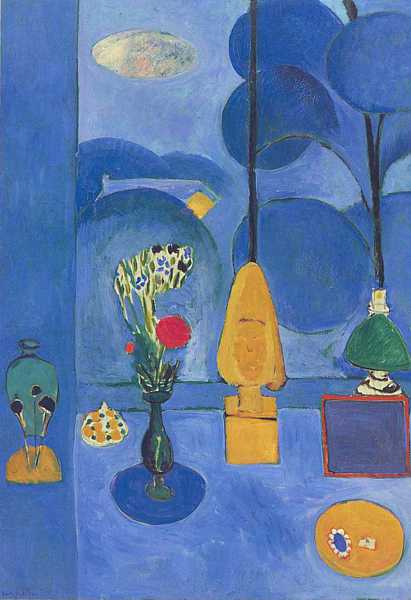
Henri Matisse - The egypt Curtain 1948
http://www.artyfactory.com/art_appreciation/still_life/henri_matisse.htm
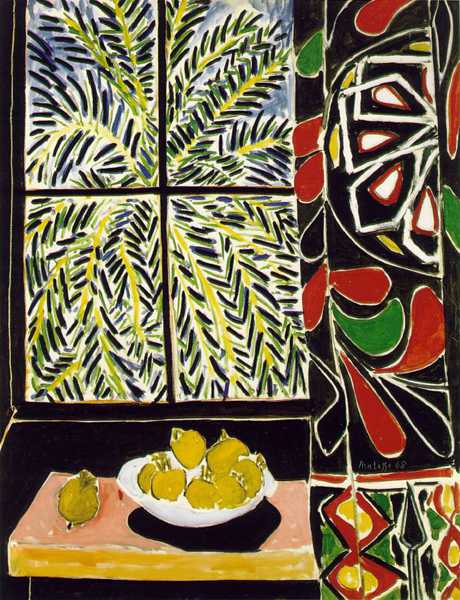
I can see in these two painting the great use of bold colour that he used - I think hes looked at the still life, took a few bold colours from it and used those to create the painting. I like the Blue window the best out of these two. I don't really like the colours used in the Egypt Curtain, the colours don't appeal to me.
2100
We are only 14 years into this century and yet there are so many people still creating art. Artists have continued to paint still life pictures. I realize now after looking back at all the centuries that there is not right or wrong way of painting a still life. As long as you understand how to create accurate drawings, apply tone and colour you can create your own style and express your own way. You may even invent a new style, who knows, but its all about having fun, enjoying painting and expressing yourself!
Exercise - Drawing With Paint.
I feel the outcome of my painting turned out well. After listening to my tutors advice and painting the picture lightly first, helped to see the composition and tone better. I like the different blues I used on the biscuit Tin and the cork made suitcase that they were placed on top of. I feel that this was a quirky composition and for an painting attempt its technique and colours worked out too. The things I felt that I could have done better on, is the biscuit tin. You can clearly see the reflective light on the little vase, but on the biscuit tin, it does not look as good as I had hoped. I was concentrating on the multi colours of blues and lost the light on the object. Another thing is the material I feel it looks like hills in a landscape and not the actual shape that was in front of me. I really need to keep practicing, looking more at what I see. I feel I have slightly improved here with the tone on the object compared to my final for assignment 1.
Exercise Still Life with flowers
For this task I decided to use some flowers I already had in my home. I loved the colours and the way the flowers draped.
I decided on a composition, which included a chair, table, material, a saucer and of course my flowers. I then practiced drawing the composition and the flowers in my sketch book.
I loved the colour contrasts I had in front of me, Violets and pinks with bright green leaves and a grey back ground which really made the composition look relaxing and appealing to the eye. The flowers are very delicate and I think the colours show this as they are soft and gentle shades.
I then began to paint the background, working to the foreground of my still life. I had trouble getting the angle of the chair right and the shadow which was hitting the wall, as I had to use very straight lines whilst painting. It was a bit of a challenge but after playing around with the paint I feel I got the best accuracy I could in that particular area. There were a lot of leaves, so to fill in the gaps between each one I used a dark green (as they were dark areas) to create depth in to the painting. I think on the right hand side on the middle lot of leaves, I added too much dark green, where there should of actually been another leaf there. I was making sure I really looked at what I could see and I think I portrayed the leaves very well. I used a mixture of green colours on the leaves to create tone and texture. I loved painting the flowers and I just let my painting arm flow. I loved how I created what I saw, delicate flowers, which was what I wanted to show. Some were pink and some were violet. I looked closely at the pink and noticed there was a hint of yellow on them which I put in to my flowers on my painting and this made all the difference. I felt it showed a kind of optical mixing in my flowers creating a more detailed look of the light and dark areas on the blooms. I also did this on the violet flowers with a hint of blue and it worked out well too.


When I finally finished the other objects in my painting I left it a few days to dry. I went and got it out of my studio area and just looked at it for a while. I am so chuffed at it. There is a few areas I could improve on such as the dark green areas and the table. I feel I needed to perhaps show more light that was coming from the right beaming off the table. I really like the outcome and it has a subtle and gentle feel to the whole painting.
Exercise - Still Life with natural Objects
For this exercise, I had already pre planned what I was going to do. I had decided on drawing some fruit and vegetables on my wooden table and chopping board. I also had a large rich wooden panel, which I thought would go great in the background. I started putting things together and was really happy with the composition I had done. I included a jug with tomato juice in, some bright coloured peppers and some mint plant. I felt the green of the mint plant really worked against its complimentary colour red (tomatoes) .
The brown colours on the wood panel and the chopping board, also complimented the whole scheme. I decided to put my objects to the left hand side of my painting, to show part of my wood panel, as I really likes the patterned texture on it. I tested it out in my sketch book and it looked great.


I stared to paint it by putting in the wooden panel first. I really looked at the grains in the wood and the rich browns and yellows, I could see. I feel I did well with the grain of the wood, which flowed across the background. I then did the table top of my painting which was a light bark colour, the wood looked very rustic and old so I tried to portray this in to the painting. I then started on the leaves, jug and the fruit. I really like how I captured the jugs form It shows all the bounces of light I could see. I think I made an error with the main orange, in the middle of the chopping board because it's come out a lot darker then it should be. I have not shown enough detail inside the fruit. I think I need to really work carefully in some areas to grasp what I am looking at better. Once finished that area I moved on to the final few parts, chopping table, leaf in foreground and the chili's on the table. I really was impressed by how I showed the chili. I think I got the shine on them accurately and I love the bright colours I used. I feel that I could of put more detail on the leaves, by introducing more tone but I felt I wanted the fruit to stand out the most.





Overall I feel this was a good attempt at this still life. There are a few areas I would change or improve on but its another learning curve. From this painting I have started to learn how to put certain colours together to help produce an appealing painting. I have also learned about textures of wood and to observe the patterns that are within.
Overall
I really enjoyed this task, to paint two different still life's. My favorite one is the flower painting I did. I found this more appealing to me and I enjoy making subtle and easy on the eye contrasts. I feel that this is a type of style I would use to portray my own voice, as I enjoyed painting it so much. It is a very tranquil painting and I like that I didn't try too hard with this, I just let my self flow and go with what I was seeing. I think the problems you may have with drawing natural objects are the textures. Objects such as fruit and flower tend to die and rot. If your taking a while to paint and study the objects, they tend to change colour slightly or shape. I also think what's hard is showing juices of a fruit eg a orange in the painting. I think on both painting I made good and bad choices. On the fruit and vegetable one, I think had a good composition but I needed to improve on looking at the orange more and putting more tone on the leaves. In my flower painting, I think I did the correct composition . The flaws if I have to really criticize my work, is the saucer on the right of the table. It does not look perfectly round and maybe I should of spent some more time concentrating on that. My method of painting was to portray a gentle soft painting and I think I did well with this, by using soft colours with a grey back ground to make my flowers stand out. I have learned from both exercises that natural objects are for me, more enjoyable to paint and draw. I love the bright colours and all the textures each individual object has, compared to a man made objects, where it's mainly metals and pottery a etc, with little textures in my opinion. I like the idea of mixing natural with man made objects though as I feel that helps with a painting to give it more of a character . I really enjoyed painting these and I am keen to explore painting more and what works for me.













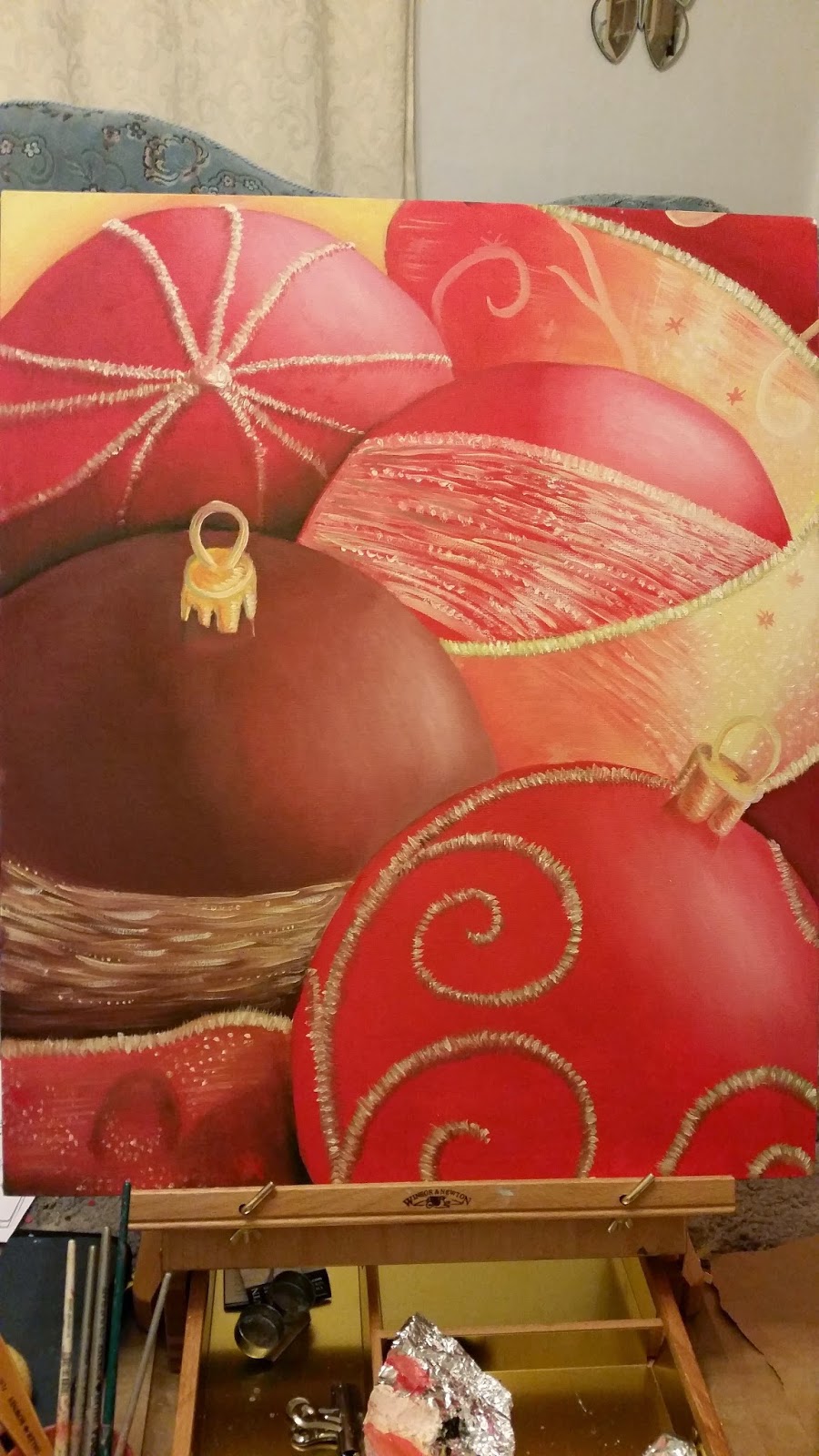





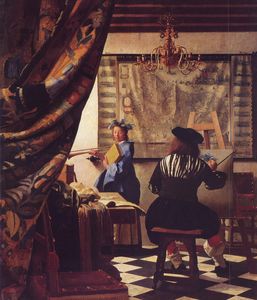
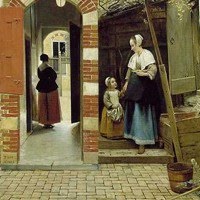

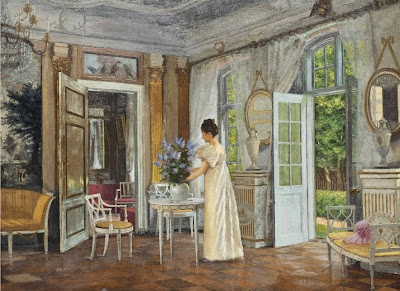.jpg)
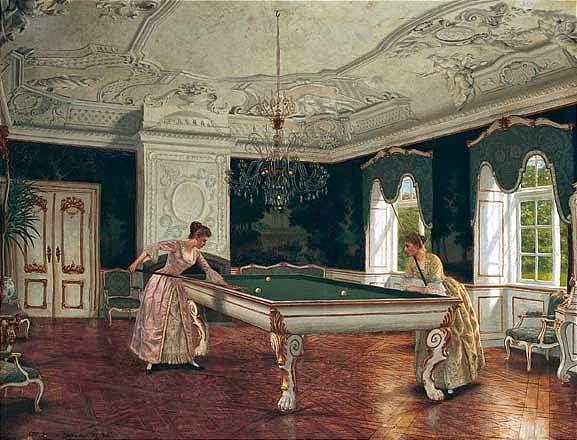.jpg)





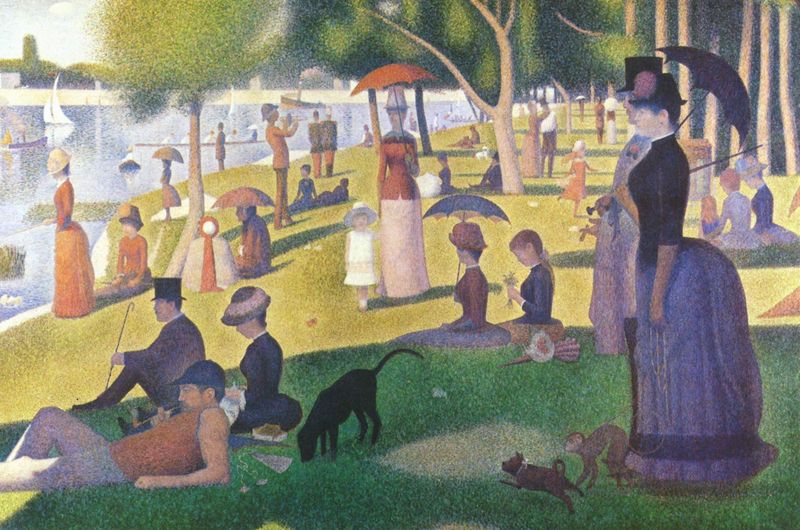


-1890.jpg)










































